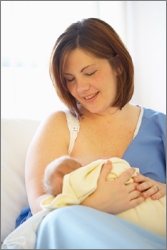11 Myths About Breast Cancer You Probably Thought Were True
by www.SixWise.com
Aside from skin cancers, breast cancer is the most frequently diagnosed cancer in women, so as you have probably heard there's a lot of talk about this disease. However, not all of it is true.
|

Though breast cancer is more common in older women, young women can also be at risk.
|
Myth #1: Only women can have breast cancer.
Reality: Although it occurs much less frequently, accounting for only about 1% of all breast cancer cases, men can also have breast cancer. On average, some 450 men die annually from the disease. Breast cancer in men occurs most often between the ages of 60 and 70, typically due to radiation exposure, family history of breast cancer, or high estrogen levels resulting from such diseases as Klinefelter's syndrome and cirrhosis.
Myth #2: Only women with a family history of breast cancer can develop the disease.
Reality: Approximately 80% of women diagnosed with breast cancer have no family history of the disease. A family history of breast cancer may increase your risk of developing the disease, but your physician or genetic counselor should be able to determine your risk level more accurately.
Myth #3: Since I don't have a mutated BRCA1 or BRCA2 gene, I can't get breast cancer.
Reality: Only about 5% of breast cancer cases are due to abnormal genes. A mutated BRCA gene does not necessarily mean you will develop breast cancer as it is only one of a number of risk factors. Other risk factors include age, poor diet, obesity, family history, beginning menstruation at an early age, menstruation past the age of 50, not having children, or having your first child after age 30, and exposure to radiation.
Myth #4: Young women don't have to worry about getting breast cancer.
Reality: Although your chances of getting breast cancer increase with age (age being one of the strongest risk factors associated with breast cancer), women of all ages are potentially at risk.
| A Woman's Chances of Breast Cancer Increases With Age |
| By age 30 |
1 out of 2,212 |
| By age 40 |
1 out of 235 |
| By age 50 |
1 out of 54 |
| By age 60 |
1 out of 23 |
| By age 70 |
1 out of 14 |
| By age 80 |
1 out of 10 |
| Ever |
1 out of 8 |
Myth #5: Most lumps found in the breast are cancerous.
Reality: Approximately 80% of lumps are a result of benign (non-cancerous) changes in the breast. However, the percentage of benign breast lumps may decrease with age because older women are at a higher risk for breast cancer. But any breast abnormality should be reported to your physician.
Myth #6: Mammograms are the safest, most effective way to check for breast cancer.
Reality: There is much controversy surrounding the mammogram's safety and effectiveness. Mammograms expose you to radiation, which in turn can cause cell mutation. Consequently, pressure from the machine can spread cancerous cells. A study published in the journal Archives of Internal Medicine showed that radiologists who interpreted mammogram slides were found to misdiagnose cancer 42% of the time, while 21% of the time cancer went undetected.
Your physician may order a mammogram to investigate a lump further, however, consider thermography instead -- it is a highly accurate, non-invasive way to detect cancerous tissue without the harmful radiation caused by mammograms. In addition, very early cancer detection is possible.
|

Despite the myth, there is no evidence that breastfeeding increases a woman's risk of breast cancer. In fact, it may actually lower it.
|
Myth #7: Breastfeeding will increase my risk of breast cancer.
Reality: There is no evidence that shows breastfeeding will increase the risk for breast cancer. Some evidence shows that breastfeeding may actually decrease a woman's risk of developing breast cancer.
Myth #8: Lumps are the only form of breast cancer.
Reality: A lump may or may not indicate breast cancer -- and most lumps are benign. However, there are other signs that may indicate cancer:
-
Swelling of the breast
-
Swelling of lymph nodes in underarm
-
Skin irritation or dimpling
-
Thickening skin of breast or nipple
-
Redness or scaliness of breast/nipple skin
-
Bruise-like area on breast
-
Breast or nipple pain
-
Inverted or retracted nipple
-
Bloody or watery nipple discharge
Myth #9: Wearing an underwire bra can cause breast cancer.Reality: There is no scientific evidence that supports the idea that underwire bras cause cancer. It was proposed that toxins accumulated in the breast because of compression of the lymphatic system due to pressure from the underwire. The result was believed to be breast cancer, however this has never been proven. Tightness of your bra, whether it has an underwire or not, has not been shown to have any connection to breast cancer.
Myth #10: Drinking coffee causes breast cancer.
Reality: Thus far no evidence has shown any link between caffeine and breast cancer. There is, however, some evidence that shows caffeine may be responsible for lowering your risk for breast cancer.
Myth #11: There is no way to avoid breast cancer if I'm at high risk.
Reality: There are many different ways to help prevent and reduce the risk of breast cancer. Conventional medicine may recommend certain medications, such as Tamoxifen, Evista or Selective Estrogen Receptor Modulators (chemoprevention), or even preventive surgery, such as removing one or both of your breasts if you are at high risk, although these options do carry risks of side effects. Alternatively, the simple lifestyle strategies that follow may also help reduce your breast cancer risk.
-
Ask your doctor about aspirin
Taking an aspirin just once a week may help protect against breast cancer, but be sure to talk to your doctor before you start. When used for long periods of time, aspirin can cause stomach irritation, bleeding and ulcers. More serious aspirin side effects include bleeding in the intestinal and urinary tracts and hemorrhagic stroke. In general, you're not a candidate for aspirin therapy if you have a history of ulcers, liver or kidney disease, bleeding disorders, or gastrointestinal bleeding.
-
Limit alcohol
Drinking alcohol is strongly linked to breast cancer. The type of alcohol consumed -- wine, beer or mixed drinks -- seems to make no difference. To help protect against breast cancer, limit the amount of alcohol you drink to less than one drink a day or avoid alcohol completely.
-
Maintain a healthy weight
There's a clear link between obesity -- weighing more than is appropriate for your age and height -- and breast cancer. The association is stronger if you gain the weight later in life, particularly after menopause.
-
Avoid long-term hormone therapy
The link between postmenopausal hormone therapy and breast cancer has been a subject of debate for years, partly because research results have been mixed. Estrogen exposure clearly contributes to breast cancer risk, but for most women, the size of the contribution over a lifetime is small -- particularly in the absence of other risk factors, such as family history of the disease. If you're approaching menopause and having frequent symptoms, it's probably safe to take hormones for as long as four to five years. Any longer does increase your breast cancer risk, without conferring any clear benefits. The same is true of hormone therapy after age 60. Many experts recommend natural, bioidentical hormones as a safe alternative to synthetic varieties.
-
Stay physically active
No matter what your age, aim for at least 30 minutes of exercise on most days. Try to include weight-bearing exercises such as walking, jogging or dancing. These have the added benefit of keeping your bones strong.
-
Eat foods high in fiber
Try to increase the amount of fiber you eat to between 20 and 30 grams daily -- about twice that in an average American diet. Among its many health benefits, fiber may help reduce the amount of circulating estrogen in your body. Foods high in fiber include fresh fruits and vegetables and whole grains.
-
Emphasize olive oil
A Northwestern University study, published in the journal Annals of Oncology, found that oleic acid -- the main component of olive oil -- inhibited activity levels of the Her-2/neu gene. This gene is thought to trigger breast cancer and is found in over one-fifth of breast cancer patients. The gene is associated with highly aggressive tumors and poor prognosis.
- Avoid exposure to pesticides
The molecular structure of some pesticides closely resembles that of estrogen. This means they may attach to receptor sites in your body. Although studies have not found a definite link between most pesticides and breast cancer, it is known that women with elevated levels of pesticides in their breast tissue have a greater breast cancer risk.
Further, scientists are also investigating a number of potential preventive therapies for breast cancer, including:
-
Retinoids
Natural or synthetic forms of vitamin A (retinoids) may have the ability to destroy or inhibit the growth of cancer cells. Unlike other experimental therapies, retinoids may be effective in premenopausal women and in those whose tumors aren't estrogen positive. Research is ongoing.
-
Flaxseed.
Flaxseed is high in lignan, a naturally occurring compound that lowers circulating estrogens in your body. Flaxseed appears to decrease estrogen production -- acting much like the drug Tamoxifen does -- which may inhibit the growth of breast cancer tumors. Lignans are also antioxidants with weak estrogen-like characteristics. These characteristics may be the mechanism by which flaxseed works to decrease hot flashes. Further research should clarify the connection.
Recommended Reading
Are Self Breast Exams Harmful? What Every Woman Needs to Know.
Eight Key Nutrients to Help Prevent Breast Cancer - and Where to Find Them.
Sources
Cornforth, Tracee. About.com: Women's Health. 7 Myths About Breast Cancer. October 2008.
BreastCancer.org. Myths About Breast Cancer. June 20, 2008.
Health.com. 25 Breast Cancer Myths and Misunderstandings. October 2008.
Imaginis.com. Myths About Breast Cancer. October, 2008.
Mayo Clinic. Breast Cancer. October 2008.
Medline Plus. Male Breast Cancer. October 2008.